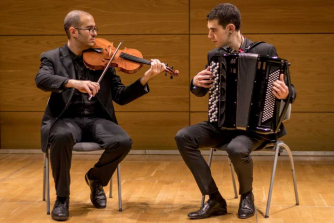Details
1901 Arts Club
7 Exton Street
Waterloo
London
SE1 8UE
England
Programme
Heitor Villa-Lobos – Bachianas brasileiras no.5, W389-391
Astor Piazzolla – Le Grand Tango
Lucas F. Jordan – Burdened Berimbau
Bernardo Simões – Reflection
Astor Piazzolla – Oblivion
Rafael Marino-Arcaro – Mapinguari
Heitor Villa-Lobos – Bachianas brasileiras no.4, W264, 424
Performers
Michael Iskas – viola
Iñigo Mikeleiz Berrade – accordion
Diphonon Duo
Programme Note
Poliphonia is delighted to present Diphonon Duo with the original combination of accordion and viola in a programme with several premières and a special celebration of the centenary of Piazzolla.
Diphonon Duo is a viola and accordion duo formed by the Greek viola player Michael Iskas and Iñigo Mikeleiz Berrade, accordionist from Navarra (Spain). Michael and Iñigo met in 2015 during their Masters of Arts studies at the Royal Academy of Music and after discovering they share common musical interests, they decided to establish this ensemble.
The word "Diphonon" means in Greek "two voices".
The combination of accordion and viola, bow and bellows, is an unusual duo, however the two instruments have more similarities than we think, since both are able to sustain sound for a long time and vary its color and intensity. For string players, this possibility is a very interesting item to explore. The great cello player Mstislav Rostropovich said that "If cellists want to discover the possibilities of the cello, they should play with accordion and not piano".
The repertoire performed by Diphonon Duo reaches different styles and ages. From original works for the duo, to transcriptions of baroque and classical music. The duo involve the audience in a journey through time and space, from the 17th century, with the great British composer Henry Purcell, to the present day, being able to appreciate contemporary but very stylistically different pieces from distant countries such as Argentina, Denmark, Spain, the eastern Mediterranean Sea and Japan. Many of the works performed by Diphonon Duo reflect traditional elements of various regions of the world (for example dances, rhythms, songs). The ensemble’s repertoire includes composers such as Benjamin Britten, Astor Piazzolla, Graciane Finzi, Martin Lohse, Arvo Pärt, Gorka Hermosa, J.S. Bach and many others. As the repertoire for this combination of instruments is quite limited, Diphonon Duo has drawn the attention of several contemporary composers who have written music (or are in the process of doing it) for them, including Edmund Hunt, Lewis Murphy, Juan Cazcarra, Nikki Franklin or Joaquín Taboada. For some of the commissions, the duo has been supported by the Arts Council, Royal Philharmonic Society and private donors as they are constantly researching and discovering new opportunities which can provide resources for projects, promote and make their music accessible (funding, schemes, concerts, etc). As a result of this process, they will be releasing their debut CD in Autumn 2021 for the label Lindoro, containing some of these works.
Diphonon Duo performs in various venues in London and Spain such as the Wigmore Hall, St Martin-in-the-Fields, St James's Piccadilly, Royal Academy of Music, British Museum, Bristol Beacon, Seamus Heaney Home Place (Bellaghy, Northern Ireland) and Civican Centre (Pamplona, Spain).
During the course 2017-18 they were appointed as Wigmore Hall Learning Ensemble, being regular collaborators since then, and from 2019 they are members of Live Music Now, an organization that works with a very diverse range of people that rarely, if ever, have the opportunity to experience live music. Outreach work is in the core of Diphonon Duo’s values and aims, since they believe in the power of music for breaking barriers and bringing people together.
The duo has received coaching and guidance from eminent musicians such as Owen Murray, Mario Stefano Pietrodarchi, Mie Miki, and Bjarke Mogensen (accordionists), and James Sleigh, Roger Chase, and Garth Knox (violists). This has shaped the stylistic perception of the ensemble depending always on the unique character of each composition.

 Your events at Classical Events
Your events at Classical Events

